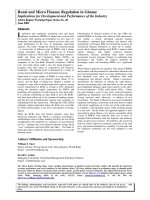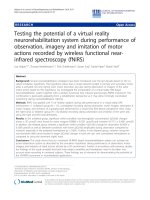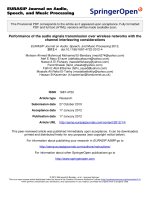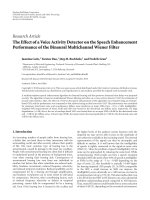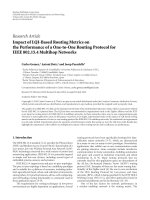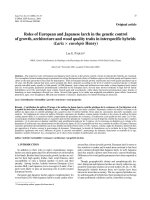Mean performance of the national and international coconut accessions for the yield attributing and nut quality traits
Bạn đang xem bản rút gọn của tài liệu. Xem và tải ngay bản đầy đủ của tài liệu tại đây (295.08 KB, 10 trang )
Int.J.Curr.Microbiol.App.Sci (2019) 8(2): 2597-2606
International Journal of Current Microbiology and Applied Sciences
ISSN: 2319-7706 Volume 8 Number 02 (2019)
Journal homepage:
Original Research Article
/>
Mean Performance of the National and International Coconut Accessions
for the Yield Attributing and Nut Quality Traits
G.N. Khadke1*, V. Niral2, M.S. Kulkarni3, N.K. Hegde4,
N. Sandhyarani1 and M.B.N. Naika1
1
College of Horticulture, Arabhavi, UHS, Bagalkot, Karnataka, India
2
ICAR-CPCRI, Kasaragod, Kerala, India
3
PGS, University of Horticultural Sciences, Bagalkot, Karnataka, India
4
College of Horticulture, Sirsi, UHS, Bagalkot, Karnataka, India
*Corresponding author
ABSTRACT
Keywords
Coconut,
Accessions, Cocos,
Arecaceae
Article Info
Accepted:
20 January 2019
Available Online:
10 February 2019
The mean performance study was carried out in coconut for the growth, yield and nut
quality traits of exotic and indigenous coconut accessions which is maintained at ICAR,
CPCRI, RC, Kidu. Wide variations on the growth parameters observed in the within the
studied accessions. Among the twenty eight accessions, maximum vegetative characters
viz., trunk girth at 1.5m height of stem in Bari Narikel-II (102.7 cm), number of functional
leaves in Sambava Green Tall (36.1), length of petiole (172.0 cm) and length of leaflet
bearing portion (464.5 cm) in Comoros Red Tall and number of paired leaflet in King
Kumbra Tall (123.2) were recorded. The total bunches on the crown was recorded high in
Bari Narikel II (17.6), number of bunches on crown with below fist size fruits (4.0) was
high in the Comoros Tall Uzirpur Tall, Bari Narikel II and Sri Lankan Yellow Dwarf II
and above fist size was high in Bari Narikel II (13.6). The mean number of fruits below fist
size was recorded more in Chinashukania Tall (321.9) and above fist size fruits recorded
high in Sambava Green Tall (131.5). The maximum nut characters viz., whole fruit weight
(1734.7 gm), per cent of husk to whole nut weight (47.4 %) and fresh endosperm (449 gm)
were observed in Guelle Rose Tall and Volume of endosperm cavity was in Sri Lankan
Red Dwarf II (339.4 ml). From the study of mean performance of the accessions, it is
difficult to postulate a single accessions with all the desirable traits combined together.
However, based on growth and various yield attributing traits, the tall accessions Bari
Narikel-II, Chandan Nagar Tall, Panama Tall, West Coast Tall, Rupdia Tall and
Kayemkola Tall can be grouped as promising for the productivity traits. Hence, this
accession can be included in to the further breeding programme to develop the new high
yielding variety.
2597
Int.J.Curr.Microbiol.App.Sci (2019) 8(2): 2597-2606
and characterization of vegetative and nut
characters for yield and nut quality.
Introduction
Coconut (Cocos nucifera L.) is the most
extensively grown and used crop in the world.
It is referred as King of tropical palms and
plays a major role in the economic, cultural
and social life of more than 80 tropical
countries. It is a diploid with chromosome
number of 2n = 32 and is traditionally seed
propagated with slow growing habit.
Purseglove (1968) agreeing with an coconut
originated from South East Asia and
distributed to many parts of the world
including Central and South America, East
and West Africa, East Asia and the Pacific
Islands. India is the third largest coconut
producer after Indonesia and Philippines with
total production of 152.56 lakh tonnes from
an area of 20.88 lakh hectares. In India, Tamil
Nadu, Kerala, Karnataka, Andhra Pradesh and
Maharashtra are the major producing states
(Anon., 2017). Since coconut is a cross
pollinated crop, propagated only through
seed, it is highly heterozygous in nature. The
dissemination of coconut seeds was achieved
through floating in sea currents and
subsequent germination on the shore,
followed by further human dispersal in
various coconut growing countries (Ohler,
1984) and hence the present population
differentiation is due the geographic isolation,
introgressive hybridization, natural mutation
and selection process by human (Perera et al.,
2000).
The yield of coconut, being a complex
character, is controlled by a number of
components
and
their
interaction.
Identification of suitable genotypes with
superior quality as consumer preference and
more number of nuts per palm as farmer’s
preference will be a favourable step. Hence,
coconut accessions, representing indigenous
and exotic collection maintained in the ex situ
field gene bank at ICAR-CPCRI Research
Centre Kidu, are proposed for investigation
Materials and Methods
The uncharacterized and recent twenty five
tall types and three dwarf type accessions
collected and maintained at ICAR- CPCRI,
research Centre, Kidu has been selected for
the present study (Table 1). Among the
twenty eight coconut accessions, twenty three
exotic and five indigenous types were of
different
geographical
origins.
The
experiment was laid out in a randomized
block design (RBD) with 3 replications with
each accession representing 2 palms per
replication and accessions taken for study
were planted at a distance of 7.5 m x 7.5 m.
These accessions were of 18-20 years old at
the time of this experiment. Recommended
package of practices were followed for all the
genotypes (Nampoothiri et al., 2000).
According to the standard procedures (Anon,
1995; Ratnambal et al., 1995 and Ratnambal
et al., 2000a) the descriptor traits and DUS
test traits notified by PPV and FR Authority
(Anon, 2011) was recorded for two seasons.
Observations were recorded from all the
palms representing each accession in each
replication on vegetative and nut characters.
Observations were recorded twice, once
during August-2016 to September 2016 and
another between August-2017 to September2017 with one year interval. The two year
mean values of all the above quantitative
characters of the 28 accessions were subjected
to statistical analysis. The mean, standard
error of deviation and co-efficient of variation
were calculated according to Panse and
Sukhatme (1961).
Results and Discussion
In the present investigation, significant
differences were observed growth characters
2598
Int.J.Curr.Microbiol.App.Sci (2019) 8(2): 2597-2606
like palm trunk girth at 1.5m height, total
number of leaves on the crown, petiole length,
length of leaflet bearing portion and number
of paired leaves among the accessions (Table
2).
Among the twenty eight accessions studied,
the differences in stem girth are readily
noticeable between palms belonging to
different accessions. Long (1993) classified
the tall and dwarf based on the stem girth and
revealed that the tall varieties showed straight
and thick stem at base as compared to dwarf
types. Higher trunk girth at 1.5 m height was
observed in Bari Narikel-II (102.7 cm) and
followed by Comoros Green Tall (101.0 cm)
whereas; lowest girth (52.0 cm) was recorded
in Coco Bleu Tall.
photosynthetic efficiency. Longer the leaf and
petiole, the weaker it seems to be and unable
to provide ample support to its fruit and
bunch. On the other hand, shorter leaves
provide adequate support to its bunch (Pieries,
1934). In the present study length of leaf
petiole ranged from 90.4 cm in Coco Bleu
Tall and 172 cm in Comoros Red Tall. The
accessions, Bari Narikel-II, Rupdia Tall,
Panama Tall and Bagharpara Tall also
recorded higher length of petiole. Generally
petiole length was higher in tall accessions
than in dwarf accessions. Ratnambal et al.,
(1995), Renuga (1999), Ratnambal et al.,
(2000), Ratnambal et al., (2002), Jerard
(2002), Arunachalam et al., (2005),
Samsudeen et al., (2013) and Jerard et al.,
(2017) also reported similar results.
Annually a palm produces twelve leaves and
the number of available functional leaves at a
time decides the health of the palms which
will reflect on the nut production. Iyer (1980)
reported that the increase in trunk height with
simultaneous increase in number of leaves
contributed to the overall yield of the palm.
Regarding the leaf characters viz., number of
leaves, length of petiole, length of leaflet
bearing portion, number of paired leaflets,
length of leaflet, breadth of leaflet among the
twenty eight accessions showed noticeable
variation amongst themselves. In this study,
the average numbers of leaves per palm
varied from 23.6 in Coco Bleu Tall and 36.1
in Sambava Green Tall, with a mean value of
28.2 leaves. Generally, the number of leaves
was higher in tall accessions than dwarf types.
Ratnambal et al., (1995), Renuga (1999),
Ratnambal et al., (2000), Ratnambal et al.,
(2002), Arunachalam et al., (2005), Princy
(2013), Samsudeen et al., (2013), Suchithra
(2014), Perera et al., (2016a) and Jerard et al.,
(2017) also reported similar results. Petiole
and leaf length an important character, since it
decides the ability of the leaf to support
bunches in its axils and also the
The length of leaflet bearing portion decides
the number of leaflets borne on the leaves.
Higher the number of leaflets higher is the
yield as reported by Nair and Nampoothiri
(1993) and Ratnambal et al., (1995). The
greater length of leaflet bearing portion in
leaves was registered in the accession
Comoros Red Tall, followed by Comoros
Green Tall and Bari Narikel-II. The smallest
length of leaflet bearing portion was recorded
in Sri Lankan Red Dwarf II followed by Coco
Bleu Tall in the present study. Among the
twenty eight accessions, the mean number of
paired leaflets on both sides of the leaves
ranged from 89.8 to 123.2. The highest
number of leaflets was recorded by King
Kumbra Tall followed by Comoros Red Tall,
Comoros Green Tall and Panama Tall. The
length of leaflet bearing portion and number
of leaflets was lesser in dwarf accessions as
reported by Ratnambal et al., (1995), Renuga
(1999),
Ratnambal
et
al.,
(2000),
Arunachalam et al., (2005), Suchithra (2014),
Perera et al., (2016a) and Jerard et al., (2017).
In the present study also lesser number of
leaflets was recorded in Sri Lankan Red
Dwarf II. Hence this trait could be utilized for
2599
Int.J.Curr.Microbiol.App.Sci (2019) 8(2): 2597-2606
the identification of dwarf/tall palms during
germplasm collection programmes. Total
bunches on the crown was recorded and found
to be highest (17.6 bunches) in Bari Narikel-II
and lowest (9.6 bunches) in Comoros Green
Tall. Average number of bunches on the
crown with below fist size fruits varied from
2.5 in Sambava Tall to 4.0 in Comoros Tall,
Uzirpur Tall, Bari Narikel-II and Sri Lankan
Yellow Dwarf II. The mean number of fruits
below fist size per palm was the highest in
Chinashukania Tall (321.9) while the
accession Kayemkola Tall recorded the
lowest number as 61.5. Higher number of
fruits below fist size was also observed in
Agailjhara Tall (266.4) and Bhagarapara Tall
(236.0).
Table.1 Details of coconut accession selected for mean performance study
Sl. No.
1
2
3
4
5
6
7
8
9
10
11
12
13
14
15
16
17
18
19
20
21
22
23
Code
SGT
ST
SLYD
Accession name
Sambava Green Tall
Sambava Tall
Sri Lankan Yellow Dwarf
II
SLRD Sri Lankan Red Dwarf II
GTBT Gon Thembili Tall II
CMT Comoros Tall
CMRT Comoros Red Tall
CMGT Comoros Green Tall
BHT Bagharpara Tall
KHT Khairtala Tall
UZT Uzirpur Tall
AGHT Agailjhara Tall
RUPT Rupdia Tall
KYKT Kayemkola Tall
CHST Chinashukania Tall
BNII Bari Narikel-II
BNI
Bari Narikel-I
PBT
Pubail Tall
CBT Coco Bleu Tall
GRT Guelle Rose Tall
KKT King Kumbra Tall
DUT De La Reunion Tall
CNT Chandan Nagar Tall
Habit
Tall
Tall
Dwarf
Origin
Madagascar
Madagascar
Sri Lanka
Dwarf
Tall
Tall
Tall
Tall
Tall
Tall
Tall
Tall
Tall
Tall
Tall
Tall
Tall
Tall
Tall
Tall
Tall
Tall
Tall
Sri Lanka
Sri Lanka
Madagascar
Comoros
Comoros
Bangladesh
Bangladesh
Bangladesh
Bangladesh
Bangladesh
Bangladesh
Bangladesh
Bangladesh
Bangladesh
Bangladesh
Seychelles
Mauritius
Maldives
Reunion
India, West
Bengal
India, Orissa
India, West
Bengal
Panama
India, Kerala
India, Kerala
24
25
TNT
BT
Tinisera Tall
Barajaguli Tall
Tall
Tall
26
27
28
PT
WCT
COD
Panama Tall
Indian West Coast Tall
Chowghat Orange Dwarf
Tall
Tall
Dwarf
2600
Int.J.Curr.Microbiol.App.Sci (2019) 8(2): 2597-2606
Table.2 mean performance of the coconut accessions for the vegetative growth characters
Sl.
No.
1
2
3
4
5
6
7
8
9
10
11
12
13
14
15
16
17
18
19
20
21
22
23
24
25
27
29
30
Accessions
Code
SGT
ST
SLYD
SLRD
GTBT
CMT
CMRT
CMGT
BHT
KHT
UZT
AGHT
RUPT
KYKT
CHST
BNII
BNI
PBT
CBT
GRT
KKT
DUT
CNT
TNT
BT
PT
WCT
COD
Mean
S. Ed
CD at 5 %
CV (%)
Trunk
girth at
1.5 m
height
(cm)
75.2
84.3
72.3
62.0
62.5
66.0
97.0
101.0
91.3
85.6
79.7
81.2
82.7
80.5
77.0
102.7
78.3
70.7
52.0
80.7
84.7
90.0
86.7
87.0
77.8
81.8
77.0
61.5
78.9
6.13
12.15
9.5
Total
number
of leaves
on the
crown
36.1
27.0
25.3
27.0
26.2
27.3
27.2
27.7
29.7
28.1
28.4
28.2
30.3
28.4
25.2
30.5
25.8
25.3
23.6
26.7
24.8
31.3
32.8
30.0
29.4
33.7
31.4
26.8
28.2
1.36
2.69
5.9
2601
Length of
petiole
(cm)
Length of
leaflet
bearing
portion (cm)
Number
of paired
leaflets
132.3
140.3
130.7
105.7
139.7
138.7
172.0
140.0
147.1
143.9
142.6
145.3
149.4
134.3
142.3
156.5
146.8
123.7
90.4
142.7
146.5
143.7
144.1
132.4
142.3
147.1
145.4
115.3
137.9
7.28
14.42
6.5
387.7
419.2
312.7
260.7
365.0
343.5
464.5
438.5
365.8
360.7
364.4
376.4
407.8
371.7
361.0
440.7
395.6
393.3
282.1
415.8
374.8
410.0
356.8
406.5
401.9
398.8
419.4
341.4
377.5
18.52
36.67
6.0
113.0
111.0
104.0
89.8
104.7
105.8
120.3
119.3
108.2
100.1
103.0
112.2
105.5
107.1
99.9
113.1
104.3
100.9
92.2
111.7
123.2
110.5
110.3
115.3
117.9
119.3
116.1
104.2
108.4
4.58
9.07
5.2
Int.J.Curr.Microbiol.App.Sci (2019) 8(2): 2597-2606
Table.3 Mean performance of the coconut accessions for the yield characters
Sl.
No.
1
2
3
4
5
6
7
8
9
10
11
12
13
14
15
16
17
18
19
20
21
22
23
24
25
27
29
30
Accessions
Code
SGT
ST
SLYD
SLRD
GTBT
CMT
CMRT
CMGT
BHT
KHT
UZT
AGHT
RUPT
KYKT
CHST
BNII
BNI
PBT
CBT
GRT
KKT
DUT
CNT
TNT
BT
PT
WCT
COD
Mean
S. Ed
CD at 5 %
CV (%)
Total
bunches on
the crown
14.1
11.5
13.3
11.0
13.3
14.5
11.3
9.6
11.1
12.7
16.6
13.5
15.1
14.6
14.0
17.6
11.5
10.8
10.9
12.0
11.5
13.1
15.4
14.3
12.2
17.0
14.9
13.3
13.3
0.97
1.93
9.0
Number of
bunches
with fruits
below fist
size per
palm
3.50
2.50
4.00
3.33
3.50
4.00
2.83
3.17
3.00
3.58
4.00
3.25
3.83
3.33
3.33
4.00
2.75
3.33
3.33
2.67
2.67
3.17
3.67
3.17
3.67
3.67
3.75
3.75
13.3
0.97
1.93
9.0
2602
Number of
fruits below
fist size per
palm
139.5
72.5
87.0
79.5
115.3
81.8
84.3
157.0
236.0
135.8
176.8
266.4
146.5
61.5
321.9
307.1
79.5
100.1
80.2
71.0
151.0
180.3
295.2
127.7
206.1
116.6
84.0
73.9
3.39
0.28
0.55
10.2
Number of
bunches
with fruits
above fist
size per
palm
10.7
9.0
9.3
7.6
10.8
10.4
8.5
6.5
8.2
9.1
12.3
10.3
11.8
11.3
10.6
13.6
8.8
7.8
7.5
9.3
8.8
10.1
11.2
11.1
8.5
13.5
11.1
9.5
159.2
15.46
30.60
11.9
Total
number of
fruits above
fist size per
palm
131.5
69.6
62.6
67.3
56.0
69.8
45.5
58.8
85.9
88.8
87.2
75.1
90.4
84.8
73.8
107.0
71.8
47.1
44.6
45.8
61.8
49.3
86.4
69.7
88.4
97.2
75.0
82.5
9.9
0.85
1.69
10.5
Int.J.Curr.Microbiol.App.Sci (2019) 8(2): 2597-2606
Table.4 Mean performance of coconut accessions for fruit quality characters
Sl.
No.
1
2
3
4
5
6
7
8
9
10
11
12
13
14
15
16
17
18
19
20
21
22
23
24
25
27
29
30
Accessions
Code
SGT
ST
SLYD
SLRD
GTBT
CMT
CMRT
CMGT
BHT
KHT
UZT
AGHT
RUPT
KYKT
CHST
BNII
BNI
PBT
CBT
GRT
KKT
DUT
CNT
TNT
BT
PT
WCT
COD
Mean
S. Ed
CD at 5 %
CV (%)
Weight of
whole fruit
(g)
Husk to
whole nut
weight (%)
Volume of
cavity (ml)
956.3
892.1
758.3
997.5
1121.4
1021.7
1163.8
919.0
1216.5
1053.4
984.9
1217.5
1163.6
1425.0
1260.3
1365.1
1045.7
1232.6
483.0
1734.7
652.2
923.1
1165.4
1058.4
1097.9
1209.1
913.4
914.3
1075.5
116.74
231.15
13.3
39.2
40.8
35.0
28.6
28.5
37.5
38.3
37.8
30.5
34.0
34.5
34.3
37.6
37.4
33.9
35.4
38.9
34.4
35.1
47.4
47.4
36.4
36.4
41.2
43.2
36.9
41.7
23.8
656.3
92.77
183.70
17.3
184.2
175.9
184.2
339.4
287.9
219.4
247.5
193.5
310.0
258.1
246.9
291.8
268.4
322.7
299.5
315.7
196.1
289.3
168.3
283.1
159.6
246.9
274.6
213.0
201.1
258.2
175.9
285.4
36.5
3.06
6.07
10.3
Among the dwarfs, mean number of fruits
below fist size was high in Sri Lankan Yellow
Dwarf II (87.0) followed by Sri Lankan Red
Dwarf II (79.5). Average number of bunches
with above fist size fruits varied from 6.5 in
Weight of
fresh
kernel per
fruit (g)
288.4
280.6
245.0
271.8
438.3
357.9
361.5
302.5
399.6
351.7
329.9
380.7
345.1
426.2
390.0
425.6
324.2
398.2
193.3
449.0
348.9
335.2
379.2
349.8
353.3
389.3
298.7
239.3
243.6
39.04
77.29
19.6
Comoros Green Tall and 13.6 in Bari NarikelII. The mean number of fruits above fist size
per palm was the highest in Sambava Green
Tall (131.5) while the accession Coco Bleu
Tall recorded the lowest number (44.6).
2603
Int.J.Curr.Microbiol.App.Sci (2019) 8(2): 2597-2606
Among the dwarfs, it was high in Chowghat
Orange Dwarf (82.5) followed by Sri Lankan
Red Dwarf II (67.3). In present study, the
significantly higher number of nuts per bunch,
number of bunches per palm and total number
of nuts per palm was recorded in the tall
accessions (Table 3), Bari Narikel-II and
Panama Tall, Uzirpur Tall and Chandan
Nagar Tall. Similar results in West Coast Tall
were reported by Potty et al., (1980),
Suchithra (2014) and Jerard et al., (2017) on
comparison of coconut varieties and different
accession for number of bunches per palm.
Satyabalan (1993) results showed that high
female flower production and high setting per
cent contributed more for higher yield. Pillai
et al., (1991) and Thampan (1970) expressed
this trait among coconut germplasm and it is a
highly variable factor and is influenced by
management practices, season, soil condition
and manurial status, the varietal nature and
the inherent yield potential of the palm.
(322.7 ml), Bari Narikel-II (315.7 ml) and
Bhagarpara Tall (310.0 ml) and the minimum
volume of cavity was recorded in King
Kumbra Tall (159.6 ml) followed by 184.2 ml
in the Sambava Green Tall.
From the study of mean performance of the
accessions, it is difficult to postulate a single
accessions with all the desirable traits
combined together. However, based on
growth and various yield attributing traits, the
tall accessions Bari Narikel-II, Chandan
Nagar Tall, Panama Tall, West Coast Tall,
Rupdia Tall and Kayemkola Tall can be
grouped as promising for the productivity
traits. Among the dwarfs, Chowghat Orange
Dwarf, Sri Lankan Red Dwarf II can be
grouped as promising. Hence, this accession
can be included in to the further breeding
programme to develop the new for high
yielding variety.
Acknowledgment
Wide variation was observed for the nut
characters among the studied accessions
(Table 4), weight of whole fruit ranged from
483.0 g (Coco Bleu Tall) to 1734.7 g (Guelle
Rose Tall) with a general mean of 1075.5 g.
Among the dwarfs, weight of whole fruit was
higher in Sri Lankan Red Dwarf II (997.5 g)
followed by Chowghat Orange Dwarf (914.3
g). Percentage of husk to whole nut weight
ranged from 23.8 % (Chowghat Orange
Dwarf) to 47.4% (Guelle Rose Tall and King
Kumbra Tall), with grand mean 36.5%. The
range for fresh endosperm (kernel) weight
was between 193.3 g (Coco Bleu Tall) to
449.0 g (Guelle Rose Tall). Among the tall
accessions, Gon Thembli Tall II (438.3 g),
followed by Kayemkola Tall (426.2 g) and
Bari Narikel-II (425.6 g) recorded the higher
weight of fresh kernel. Volume of the
endosperm cavity was also found to vary
widely between the accessions. Sri Lankan
Red Dwarf II recorded higher cavity volume
of 339.4 ml followed by Kayemkola Tall
A first author is grateful to ICAR for
awarding study leave to complete higher
studies, Ph.D. Horticulture programme. Also
to ICAR-CPCRI, RC, Kidu to provide the
facility to conduct the research work
smoothly.
References
Anon, 1995, IPGRI-Descriptors for coconut
(Cocos nucifera L.). International plant
genetic resources institute, Rome, Italy.
p19.
Anon, 2011, Guidelines for the conduct of test
for distinctiveness, uniformity and
stability on coconut (Cocos nucifera
L.). Plant Variety J. India. 5 (2&3):3347.
Anon, 2017, Horticultural statistics at a
Glance
2017,
pp:
144-145.
.
Arunachalam, V., Jerard, B. A., Damodaran,
2604
Int.J.Curr.Microbiol.App.Sci (2019) 8(2): 2597-2606
V., Ratnamball, M. J. and Kurnaranl, P.
M., 2005. Phenotypic diversity of foliar
traits in coconut germplasm. Genet.
Resour. Crop Evol., 52: 1031-1037.
Iyer, R. D., 1980, Central Plantation Crop
Research Institute. Annual Report, pp
11-13.
Jerard, B. A, 2002, Studies on the mean
performance, variability, association
analysis, stability and diversity in
coconut (Cocos nucifera L.) genotypes.
Ph.D. thesis submitted to Tamil Nadu
Agricultural University, Coimbatore,
India.
Jerard, B.A., Rajesh, M.K., Thomas, R.J.,
Niral, V. and Samsudeen, K., 2017,
Island Ecosystems host rich diversity in
coconut (Cocos nucifera): Evidences
from
Minicoy
Island,
India. Agricultural Research, 6 (3):
214-226.
Long, V. V., 1993, Coconut selection and
breeding programme in Vietnam. In:
Advances in Coconut Research and
Development. M. K. Nair, H. H. Khan,
P. Gopalasundaram and E. V. V. B. Rao
(Eds.), Oxford and IBH Publishing Co.
Pvt. Ltd. New Delhi, ppl07-114.
Nair, M. K. and Nampoothiri, K. V. K.,1993,
Breeding for high yield in coconut. In:
Advances in Coconut Research and
Development M. K. Nair, H.H. Khan, P.
Gopalasundaram and E.V.V.B. Rao
(Eds.), Oxford and IBH Publishing Co.
Pvt. Ltd. New Delhi, pp61-70.
Nampoothiri, K. U. K., Singh, H. P., Arulraj,
S. and Thamban, C., 2000 Coconut
cultivation
technology.
Coconut
Development Board, Kochi.
Ohler, J. G., 1984, Coconut, tree of life. –
Plant Prod. Prot. Pap. 57, Food and Agr.
Org. U. N., Rome.
Panse, V. G. and Sukhatme, P. V., 1961,
Statistical methods for agricultural
workers. ICAR, New Delhi. pp381.
Perera L., Russell, J. R., Provan, J. And
Powell, W., 2000, Use of microsatellite
DNA markers to investigate the level of
genetic diversity and population genetic
structure of coconut (Cocos nucifera
L.). Genome, 43: 15-21.
Perera, K. N. S., Herath, H. M. N. B.,
Attanayaka, D. P. S. T. G. and Perera,
S. A. C. N., 2016, Evaluation of
morphological diversity of conserved
tall coconut (Cocos nucifera L.)
germplasm in Sri Lanka. Tropical
Agric. Res., 27 (4): 350-359.
Pieries, W. V. D., 1934, Studies on coconut
palm. Tropical Agriculturist, 82: 75-97.
Pillai, R. V., Rao, E. V. V. B. and Kumaran,
P. M., 1991, Characterization of
coconut cultivars. In: Coconut Breeding
and Management. E. G. Silas, M.
Aravindakshan and A. I. Jose. (Eds),
Kerala Agricultural University, Trichur,
India. pp78-82.
Potty, N. N., Naik, B. J., Rajamony L. and
Nambiar, P. R., 1980, Comparative
performance of eight coconut varieties
in red loam soil. Indian Coconut J., 11
(15): 1-2.
Princy T., 2013 Performance evaluation of
certain hybrids and parents of coconut
(Cocos nucifera L.), M.Sc. Thesis
submitted to Tamil Nadu Agricultural
University, Coimbatore, India.
Purseglove, J. W. 1968. The origin and
distribution of the coconut. Trop. Sci.
10 (4): 191-199.
Ratnamabal, M. J., Niral, V., Krishnan, M.
and Ravi, K. N., 2000a, Coconut
Descriptors, Part II, CD-ROM, C. P. C.
R. I., Kasaragod, Kerala, India.
Ratnambal M. J., Nair, M. K., Muralidharan,
K., Bhaskara Rao, E. V. V., Pillai, R.
V., 1995, Coconut Descriptors Part 1.
C. P. C. R. I., Kasaragod, Kerala, India,
p197.
Ratnambal, M. J., Arunachalam, V., Jerard, B.
A., Rizwal, S. and Damodaran V., 2002,
Biometric analysis of diversity in
2605
Int.J.Curr.Microbiol.App.Sci (2019) 8(2): 2597-2606
Pacific Ocean coconut populations.
CORD, XVIII (2):74-88.
Renuga, M., 1999, Studies on indexing the
economic characters of varieties and
hybrids for the genetic improvement of
coconut (Cocos nucifera L.) through
selection. Ph. D. Thesis submitted to
Tamil Nadu Agricultural University,
Coimbatore, India.
Samsudeen, K., Thamban, C. Niral, V.,
Augustine Jerard, B., Rajesh, M. K.,
Manjula, C., Devadas, K. and Anitha
K., 2013, In situ approach for rapid
characterization to aid on farm
conservation of coconut germplasm - A
case study of two ecotypes from West
coast of India. J. Pl. Crops, 41 (3): 357363.
Satyabalan, K., 1993, Yield variation in West
Coast Tall coconut palms. Indian
Coconut J., December, pp5-8.
Suchithra, M., 2014, Stuides on performance
of certain indigenous and exotic
coconut genotypes (Cocos nucifera L.).
M.Sc. Thesis submitted to Tamil Nadu
Agricultural University, Coimbatore,
India.
Thampan, P. K., 1970, Hybrid palm. Cocon.
Bull., 1: 3-5.
How to cite this article:
Khadke, G.N., V. Niral, M.S. Kulkarni, N.K. Hegde, N. Sandhyarani and Naika, M.B.N. 2019.
Mean Performance of the National and International Coconut Accessions for the Yield
Attributing and Nut Quality Traits. Int.J.Curr.Microbiol.App.Sci. 8(02): 2597-2606.
doi: />
2606
